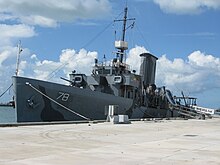Pusey & Jones

The Pusey & Jones Corporation was a shipyard and engineering company in Wilmington on the Christina River . The company existed from 1848 to 1959 and built around 500 ships from 1853 to 1945.
history
Founding years
Pusey & Jones was founded in 1848 by Joshua L. Pusey and John Jones. At first, general mechanical engineering and steam engine construction were carried out on a rented site of a whaling company and repairs were carried out. In 1851 Edward Betts and Joshua Seal, who already ran an iron foundry in Wilmington, became partners in the company, whereupon the company name changed to Betts, Pusey, Jones & Seal . From 1853, the company turned to shipbuilding and soon grew to become one of the larger shipyards for paddle steamers (ships of this type were still manufactured by Pusey & Jones until 1910). The following year, Pusey and Jones built the first iron-hulled sailing ship in the United States, the schooner Mahlon Betts . In the time ofDuring the Civil War , the shipyard first began building warships. In the middle of the 19th century, most of the paper processing machines were introduced to the USA. Pusey & Jones already produced individual parts for paper machines, but did not build complete machines. After a fire at Rockland Paper Mills , in which two machines were destroyed, their boss William Luke awarded the order to replace the two machines to Pusey & Jones, who received another pillar with the construction of machines for paper processing.
1900 to the end of the First World War
In 1891 Pusey and Jones already employed around 900 people, most of them in shipbuilding. By the turn of the century, the shipyard continued to grow and become one of the most important shipbuilding companies in the United States. The construction of merchant, work and warships was the main field of activity of Pusey & Jones, but the shipyard was best known for the construction of luxury and racing yachts (for example the Volunteer , the first yacht with a steel hull which won the America's Cup in 1887 ). In addition, the company also supplied other shipyards with ship components and marine machinery of all kinds. During the First World War, the company opened a second shipyard in Gloucester City in order to meet the high demand for shipbuilding caused by the war. The second shipyard was initially called Pennsylvania Shipbuilding Company , later also Pusey & Jones and after the construction of 19 ships, then New Jersey Shipbuilding Company . The Gloucester City shipyard built cargo ships and tankers for the United States Shipping Board and closed again after the war ended. During the war, the company's workforce grew to over 2,000.
From World War I to its closure in 1959
The economically difficult 1920s led to a reorganization in 1927 under the direction of Clement C. Smith, at the end of which the company was renamed Pusey and Jones Corporation . In the following period up to the 1930s numerous luxury yachts were built. In the course of the 1930s, there was also a growing number of orders for the construction of warships.
During the Second World War, the company reached its highest level of employment of 3600 employees, who produced on three conventional slipways and a side runway for the again high war requirements. During the war years 19 C1 ships were built for the United States Maritime Commission , several dredgers for the United States Engineer Department , mine sweepers and numerous other vehicles and conversions. One of the first Liberty ships , the Adabelle Lykes , was launched at Pusey & Jones on September 27, 1941, Liberty Fleet Day .
After the end of the war, the company stopped building ships. The last ship built by Pusey & Jones was the USS Albert J. Meyer (T-ARC-6) launched in 1946 . After that, the company turned entirely to the manufacture of paper converting machines. In 1959 Pusey & Jones closed its doors for good.
literature
- Kenneth J. Blume: Historical Dictionary of the US Maritime Industry . Historical Dictionaries of Professions and Industries Series. Scarecrow Press, Lanham 2011, ISBN 978-0-8108-5634-9 .
- Richard Urban: The City That Launched A Thousand Ships: Shipbuilding In Wilmington 1644-1997 . Cedar Tree Books, Wilmington 1999, ISBN 1-892142-06-6 .
Web links
- Entry at hagley.org (English)
- Entry and construction list at shipbuildinghistory.com (English)


